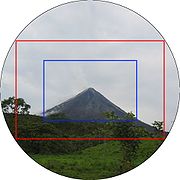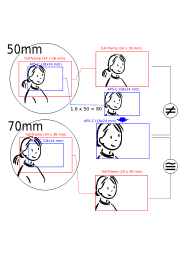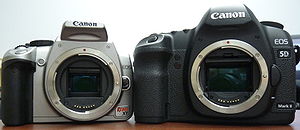
Crop factor
Encyclopedia

Digital photography
Digital photography is a form of photography that uses an array of light sensitive sensors to capture the image focused by the lens, as opposed to an exposure on light sensitive film...
, a crop factor is related to the ratio of the dimensions of a camera's imaging area compared to a reference format; most often, this term is applied to digital camera
Digital camera
A digital camera is a camera that takes video or still photographs, or both, digitally by recording images via an electronic image sensor. It is the main device used in the field of digital photography...
s, relative to 35 mm film format
135 film
The term 135 was introduced by Kodak in 1934 as a designation for cartridge film wide, specifically for still photography. It quickly grew in popularity, surpassing 120 film by the late 1960s to become the most popular photographic film format...
as a reference. In the case of digital cameras, the imaging device would be a digital sensor. The most commonly used definition of crop factor is the ratio of a 35 mm frame's diagonal (43.3 mm) to the diagonal of the image sensor
Image sensor
An image sensor is a device that converts an optical image into an electronic signal. It is used mostly in digital cameras and other imaging devices...
in question; that is, CF=diag35mm / diagsensor. Given the same 3:2 aspect ratio as 35mm's 36mm x 24mm area, this is equivalent to the ratio of heights or ratio of widths; the ratio of sensor areas is the square of the crop factor.
This ratio is also commonly referred to as a focal length multiplier ("FLM") since multiplying a lens focal length by the crop factor or FLM gives the focal length of a lens that would yield the same field of view if used on the reference format.
The term format factor is sometimes also used, and is a more neutral term that corresponds to the German word for this concept, Formatfaktor.
Introduction

Single-lens reflex camera
A single-lens reflex camera is a camera that typically uses a semi-automatic moving mirror system that permits the photographer to see exactly what will be captured by the film or digital imaging system, as opposed to pre-SLR cameras where the view through the viewfinder could be significantly...
photographers understand how their existing ranges of lenses would perform on newly introduced DSLR cameras which had sensors smaller than the 35 mm film format, but often utilized existing 35 mm film format SLR lens mounts. Using an FLM of 1.5, for example, a photographer might say that a 50 mm lens on his DSLR "acts like" its focal length
Focal length
The focal length of an optical system is a measure of how strongly the system converges or diverges light. For an optical system in air, it is the distance over which initially collimated rays are brought to a focus...
has been multiplied by 1.5, by which he means that it has the same field of view as a 75 mm lens on the film camera that he is more familiar with. Of course, the actual focal length of a photographic lens
Photographic lens
A camera lens is an optical lens or assembly of lenses used in conjunction with a camera body and mechanism to make images of objects either on photographic film or on other media capable of storing an image chemically or electronically.While in principle a simple convex lens will suffice, in...
is fixed by its optical construction, and does not change with the format of the sensor that is put behind it.
Most DSLRs on the market have nominally APS-C
APS-C
Advanced Photo System type-C is an image sensor format approximately equivalent in size to the Advanced Photo System "classic" size negatives...
-sized image sensors, smaller than the standard 36 × 24 mm (35 mm) film frame. For example, many Canon DSLRs use an APS-C sensor that measures 22.2 mm × 14.8 mm. The result is that the image sensor captures image data from a smaller area than a 35 mm film SLR camera would, effectively cropping out the corners and sides that would be captured by the 36 mm × 24 mm 'full-size' film frame.
Because of this crop, the effective field of view
Angle of view
In photography, angle of view describes the angular extent of a given scene that is imaged by a camera. It is used interchangeably with the more general term field of view....
(FOV) is reduced by a factor proportional to the ratio between the smaller sensor size and the 35 mm film format (reference) size.
For most DSLR cameras, this factor is 1.3–2.0×. For example, a 28 mm lens delivers a moderately wide-angle FOV on a 35 mm format full-frame camera, but on a camera with a 1.6 crop factor, an image made with the same lens will have the same field of view that a full-frame camera would make with a ~45 mm lens (28 × 1.6 = 44.8). This narrowing of the FOV is a disadvantage to photographers when a wide FOV is desired. Ultra-wide lens designs become merely wide; wide-angle lens
Wide-angle lens
From a design perspective, a wide angle lens is one that projects a substantially larger image circle than would be typical for a standard design lens of the same focal length; this enables either large tilt & shift movements with a view camera, or lenses with wide fields of view.More informally,...
es become 'normal
Normal lens
In photography and cinematography a normal lens, also called a standard lens, is a lens that reproduces perspective that generally looks "natural" to a human observer under normal viewing conditions, as compared with lenses with longer or shorter focal lengths which produce an expanded or...
'. However, the crop factor can be an advantage to photographers when a narrow FOV is desired. It allows photographers with long-focal-length lenses to fill the frame more easily when the subject is far away. A 300 mm lens on a camera with a 1.6 crop factor delivers images with the same FOV that a 35 mm film format camera would require a 480 mm long focus lens to capture.
Estimating sensor performance
For a given exposureExposure (photography)
In photography, exposure is the total amount of light allowed to fall on the photographic medium during the process of taking a photograph. Exposure is measured in lux seconds, and can be computed from exposure value and scene luminance over a specified area.In photographic jargon, an exposure...
, for example for a fixed focal-plane illuminance
Illuminance
In photometry, illuminance is the total luminous flux incident on a surface, per unit area. It is a measure of the intensity of the incident light, wavelength-weighted by the luminosity function to correlate with human brightness perception. Similarly, luminous emittance is the luminous flux per...
and exposure time, larger image sensor
Image sensor
An image sensor is a device that converts an optical image into an electronic signal. It is used mostly in digital cameras and other imaging devices...
s capture more photon
Photon
In physics, a photon is an elementary particle, the quantum of the electromagnetic interaction and the basic unit of light and all other forms of electromagnetic radiation. It is also the force carrier for the electromagnetic force...
s and hence produce images with less noise and greater dynamic range than smaller sensors. Due to the statistics of photon shot noise
Shot noise
Shot noise is a type of electronic noise that may be dominant when the finite number of particles that carry energy is sufficiently small so that uncertainties due to the Poisson distribution, which describes the occurrence of independent random events, are of significance...
, the desirable properties of signal-to-noise ratio
Signal-to-noise ratio
Signal-to-noise ratio is a measure used in science and engineering that compares the level of a desired signal to the level of background noise. It is defined as the ratio of signal power to the noise power. A ratio higher than 1:1 indicates more signal than noise...
(SNR) and sensor unity gain both scale with the square root of pixel area.
Since crop factor is inversely proportional to the square root of sensor area (to within a small aspect ratio-dependent factor), it is useful for estimating image sensor performance. For example, if two different-sized image sensors have the same aspect ratio and a resolution of 10 megapixels, and are made using similar technology, the larger sensor will have better signal-to-noise ratio by a factor equal to the ratio of the two sensors' crop factors. The larger sensor has the smaller crop factor and the higher signal-to-noise ratio.
Digital lenses

Image circle
The image circle, or circle of illumination, of a lens is the circular area in the image plane formed by the cone of light transmitted by the lens . Within this circle is the smaller circle for which image definition is acceptable, the circle of good definition ; however, some authors make no...
that would not cover a 24×36 mm frame, but is large enough to cover the smaller 16×24 mm (or smaller) sensor in most DSLRs. Because they cast a smaller image circle, the lenses can be optimized to use less glass and are sometimes physically smaller and lighter than those designed for full-frame cameras.
Lenses designed for the smaller digital formats include Canon EF-S lenses, Nikon DX lenses, Olympus Four Thirds System
Four Thirds System
The Four Thirds system is a standard created by Olympus and Kodak for digital single-lens reflex camera design and development.The system provides a standard that, with digital cameras and lenses available from multiple manufacturers, allows for the interchange of lenses and bodies from different...
lenses, Sigma DC lenses, Tamron Di-II lenses, Pentax DA lenses, and Sony Alpha (SAL) DT lenses. Such lenses usually project a smaller image circle than lenses that were designed for the full-frame 35 mm format. Nevertheless, the crop factor or FLM of a camera has the same effect on the relationship between field of view and focal length with these lenses as with any other lens, even though the projected image is not as severely "cropped". In this sense, the term crop factor sometimes has confusing implications; the alternative term "focal length multiplier" is sometimes used for this reason.
Crop factor of point-and-shoot cameras
Smaller, non-DSLR, consumer cameras, typically referred to as point-and-shoot cameras, can also be characterized as having a crop factor or FLM relative to 35 mm format, even though they do not use interchangeable lenses or lenses designed for a different format. For example, the so-called "1/1.8-inch" format with a 9 mm sensor diagonal has a crop factor of almost 5 relative to the 43.3 mm diagonal of 35 mm film. Therefore, these cameras are equipped with lenses that are about one-fifth of the focal lengths that would be typical on a 35 mm point-and-shoot film camera. In most cases, manufacturers label their cameras and lenses with their actual focal lengths, but in some cases they have chosen to instead multiply by the crop factor (focal length multiplier) and label the 35 mm equivalent focal length35 mm equivalent focal length
In photography, the 35 mm equivalent focal length is a measure that indicates the angle of view of a particular combination of a camera lens and film or sensor size...
. Reviewers also sometimes use the 35 mm-equivalent focal length as a way to characterize the field of view of a range of cameras in common terms.
For example, the Canon Powershot SD600 lens is labeled with its actual focal length range of 5.8–17.4 mm. But it is sometimes described in reviews as a 35–105 mm lens, since it has a crop factor of about 6 ("1/2.5-inch" format).
Magnification factor
The crop factor is sometimes referred to as "magnification factor", "focal length factor" or "focal length multiplier". This usage reflects the observation that lenses of a given focal length seem to produce greater magnification on crop-factor cameras than they do on full-frame cameras. This is an advantage in, for example, bird photography, where photographers often strive to get the maximum "reach". A camera with a smaller sensor can be preferable to using a teleconverterTeleconverter
A teleconverter is a secondary lens which is mounted between the camera and a photographic lens. Its job is to enlarge the central part of an image obtained by the objective lens...
, because the latter affects the f-number
F-number
In optics, the f-number of an optical system expresses the diameter of the entrance pupil in terms of the focal length of the lens; in simpler terms, the f-number is the focal length divided by the "effective" aperture diameter...
of the lens, and can therefore degrade the performance of the autofocus.
A given lens casts the same image no matter what camera it is attached to. The extra "magnification" occurs when the image is enlarged more to produce output (print or screen) that matches a standard output size. That is, the magnification as usually defined, from subject to focal plane, is unchanged, but the system magnification from subject to final output is increased.
Secondary effects
When a lens designed for 35 mm format is used on a smaller-format DSLR, besides the obvious reduction in field of view, there may be secondary effects on depth of fieldDepth of field
In optics, particularly as it relates to film and photography, depth of field is the distance between the nearest and farthest objects in a scene that appear acceptably sharp in an image...
, perspective
Perspective (visual)
Perspective, in context of vision and visual perception, is the way in which objects appear to the eye based on their spatial attributes; or their dimensions and the position of the eye relative to the objects...
, camera-motion blur, and other photographic parameters.
The depth of field may change, depending on what conditions are compared. Shooting from the same position, with the same lens and same f-number
F-number
In optics, the f-number of an optical system expresses the diameter of the entrance pupil in terms of the focal length of the lens; in simpler terms, the f-number is the focal length divided by the "effective" aperture diameter...
as a non-cropped (full-frame) 35 mm camera, but enlarging the image to a given reference size, will yield a reduced depth of field. On the other hand, using a different lens with the same field of view as the non-cropped camera (matching the 35 mm-equivalent focal length), at same f-number, the smaller camera's depth of field is greater.
Perspective is a property that depends only on viewpoint (camera position). But if moving a lens to a smaller-format camera causes a photographer to move further from the subject, then the perspective will be affected.
The extra amount of enlargement required with smaller-format cameras increases the blur due to defocus, and also increases the blur due to camera motion (shake). As a result, the focal length that can be reliably hand-held at a given shutter speed for a sharp image is reduced by the crop factor. The old rule of thumb that shutter speed should be at least equal to focal length for hand-holding will work equivalently if the actual focal length is multiplied by the FLM first before applying the rule.
Many photographic lenses produce a superior image in the center of the frame than around the edges. When using a lens designed to expose a 35mm film frame with a smaller-format sensor, only the central "sweet spot" of the image is used; a lens that is unacceptably soft or dark
Vignetting
In photography and optics, vignetting is a reduction of an image's brightness or saturation at the periphery compared to the image center. The word vignette, from the same root as vine, originally referred to a decorative border in a book. Later, the word came to be used for a photographic...
around the edges can give better results on a smaller sensor. However, since the image projected onto the sensor must be magnified more to make a print using a smaller sensor, lenses used on smaller formats must deliver a higher-resolution image to the sensor for acceptable quality.
External links
- FF vs APS: Real Crop Factor explained. In depth article on the crop factor in digital photography.
- DSLR Crop/Magnification Factor on The Luminous-Landscape
- "Focal Length Multiplier" on Digital Photography Review
- Digital Crop Factor About Lens Multiplication Factors and Apparent Focal Length Increase

